NCERT Solution: Areas of Parallelograms and Triangles
In Fig. 9.17, PQRS and ABRS are parallelograms and X is any point on side BR. Show that
(i) ar (PQRS) = ar (ABRS)
(ii) ar (AXS) = 1/2 ar (PQRS)

Answer
(i) Parallelogram PQRS and ABRS lie on the same base SR and between the same parallel lines SR and PB.
∴ ar(PQRS) = ar(ABRS) --- (i)
(ii) In ΔAXS and parallelogram ABRS are lying on the same base AS and between the same parallel lines AS and BR.
∴ ar(ΔAXS) = 1/2 ar(ABRS) --- (ii)
From (i) and (ii),
ar(ΔAXS) = 1/2 ar(PQRS)
In Fig. 9.17, PQRS and ABRS are parallelograms and X is any point on side BR. Show that
(i) ar (PQRS) = ar (ABRS)
(ii) ar (AXS) = 1/2 ar (PQRS)

Answer
The field is divided into three parts. The three parts are in the shape of triangle. ΔPSA, ΔPAQ and ΔQAR.
Area of ΔPSA + ΔPAQ + ΔQAR = Area of PQRS --- (i)
Area of ΔPAQ = 1/2 area of PQRS --- (ii)
Triangle and parallelogram on the same base and between the same parallel lines.
From (i) and (ii),
Area of ΔPSA + Area of ΔQAR = 1/2 area of PQRS --- (iii)
Clearly from (ii) and (iii),
Farmer must sow wheat or pulses in ΔPAQ or either in both ΔPSA and ΔQAR.
In Fig.9.23, E is any point on median AD of a ΔABC. Show that ar (ABE) = ar(ACE).

Answer
Given,
AD is median of ΔABC. Thus, it will divide ΔABC into two triangles of equal area.
∴ ar(ABD) = ar(ACD) --- (i)
also,
ED is the median of ΔABC.
∴ ar(EBD) = ar(ECD) --- (ii)
Subtracting (ii) from (i),
ar(ABD) - ar(EBD) = ar(ACD) - ar(ECD)
⇒ ar(ABE) = ar(ACE)
Answer
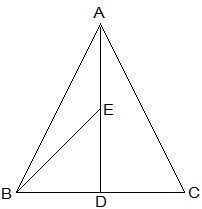
ar(BED) = (1/2) × BD × DE
As E is the mid-point of AD,
Thus, AE = DE
As AD is the median on side BC of triangle ABC,
Thus, BD = DC
Therefore,
DE = (1/2)AD --- (i)
BD = (1/2)BC --- (ii)
From (i) and (ii),
ar(BED) = (1/2) × (1/2) BC × (1/2)AD
⇒ ar(BED) = (1/2) × (1/2) ar(ABC)
⇒ ar(BED) = 1/4 ar(ABC)
Answer
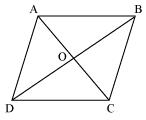
O is the mid point of AC and BD. (diagonals of bisect each other)
In ΔABC, BO is the median.
∴ ar(AOB) = ar(BOC) --- (i)
also,
In ΔBCD, CO is the median.
∴ ar(BOC) = ar(COD) --- (ii)
In ΔACD, OD is the median.
∴ ar(AOD) = ar(COD) --- (iii)
In ΔABD, AO is the median.
∴ ar(AOD) = ar(AOB) --- (iv)
From equations (i), (ii), (iii) and (iv),
ar(BOC) = ar(COD) = ar(AOD) = ar(AOB)
So, the diagonals of a parallelogram divide it into four triangles of equal area.
In Fig. 9.24, ABC and ABD are two triangles on the same base AB. If line- segment CD is bisected by AB at O, show that: ar(ABC) = ar(ABD).
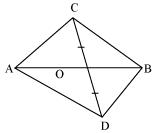
Answer
In ΔABC,
AO is the median. (CD is bisected by AB at O)
∴ ar(AOC) = ar(AOD) --- (i)
also,
In ΔBCD,
BO is the median. (CD is bisected by AB at O)
∴ ar(BOC) = ar(BOD) --- (ii)
Adding (i) and (ii) we get,
ar(AOC) + ar(BOC) = ar(AOD) + ar(BOD)
⇒ ar(ABC) = ar(ABD)
D, E and F are respectively the mid-points of the sides BC, CA and AB of a ΔABC.
Show that
(i) BDEF is a parallelogram. (ii) ar(DEF) = 1/4 ar(ABC)
(iii) ar (BDEF) = 1/2 ar(ABC)
Answer
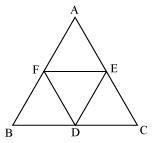
Answer
In ΔABC,
AO is the median. (CD is bisected by AB at O)
∴ ar(AOC) = ar(AOD) --- (i)
also,
In ΔBCD,
BO is the median. (CD is bisected by AB at O)
∴ ar(BOC) = ar(BOD) --- (ii)
Adding (i) and (ii) we get,
ar(AOC) + ar(BOC) = ar(AOD) + ar(BOD)
⇒ ar(ABC) = ar(ABD)
In the given figure, diagonals AC and BD of quadrilateral ABCD intersect at O such that OB = OD. If AB = CD, then show that:
(i) ar (DOC) = ar (AOB)
(ii) ar (DCB) = ar (ACB)
(iii) DA || CB or ABCD is a parallelogram.
[Hint: From D and B, draw perpendiculars to AC.]
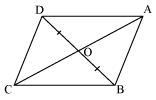
Answer
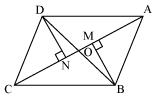
Let us draw DN ⊥ AC and BM ⊥ AC.
(i) In ΔDON and ΔBOM,
∠ DNO = ∠ BMO (By construction)
∠ DON = ∠ BOM (Vertically opposite angles)
OD = OB (Given)
By AAS congruence rule,
ΔDON ≅ ΔBOM
∴ DN = BM ... (1)
We know that congruent triangles have equal areas.
∴ Area (ΔDON) = Area (ΔBOM) ... (2)
In ΔDNC and ΔBMA,
∠ DNC = ∠ BMA (By construction)
CD = AB (Given)
DN = BM [Using equation (1)]
∴ ΔDNC ≅ ΔBMA (RHS congruence rule)
⇒ Area (ΔDNC) = Area (ΔBMA) ... (3)
On adding equations (2) and (3), we obtain
Area (ΔDON) + Area (ΔDNC) = Area (ΔBOM) + Area (ΔBMA)
Therefore, Area (ΔDOC) = Area (ΔAOB)
(ii) We obtained,
Area (ΔDOC) = Area (ΔAOB)
⇒ Area (ΔDOC) + Area (ΔOCB) = Area (ΔAOB) + Area (ΔOCB)
(Adding Area (ΔOCB) to both sides)
⇒ Area (ΔDCB) = Area (ΔACB)
(iii) We obtained,
Area (ΔDCB) = Area (ΔACB)
If two triangles have the same base and equal areas, then these will lie between the same parallels.
∴ DA || CB ... (4)
In ΔDOA and ΔBOC,
∠ DOA = ∠ BOC (Vertically opposite angles)
OD = OB (Given)
∠ ODA = ∠ OBC (Alternate opposite angles)
By ASA congruence rule,
ΔDOA ≅ ΔBOC
∴ DA = BC ... (5)
In quadrilateral ABCD, one pair of opposite sides is equal and parallel (AD = BC)
Therefore, ABCD is a parallelogram.